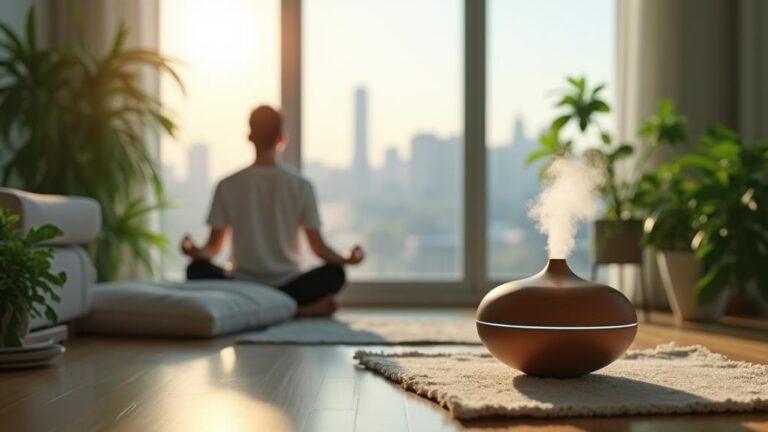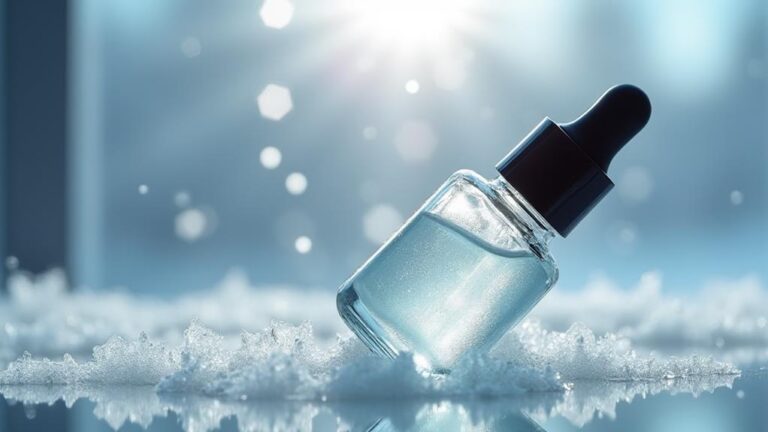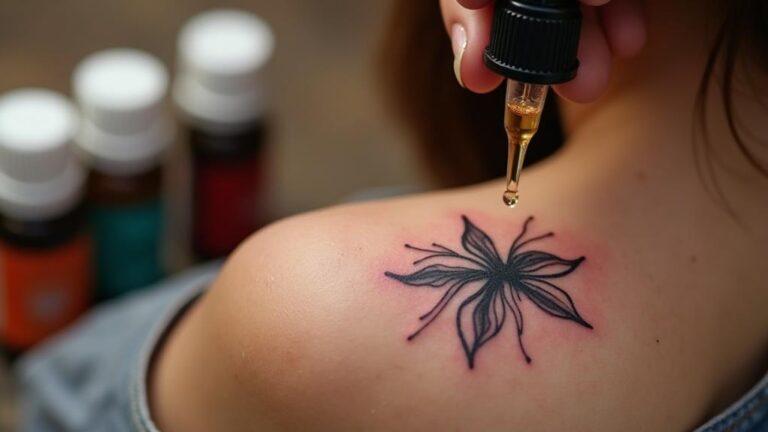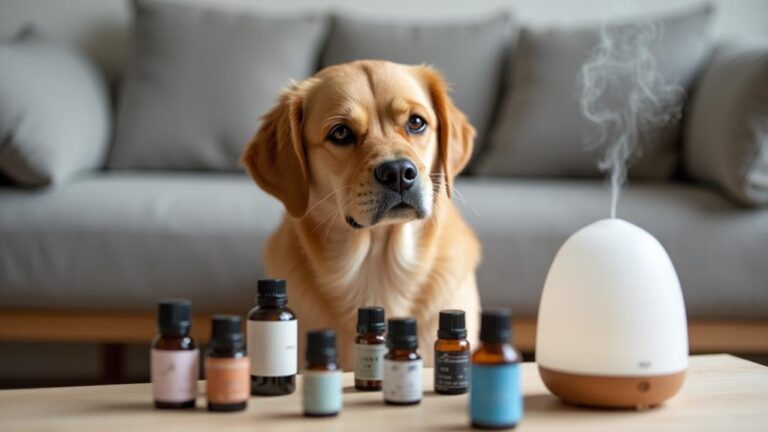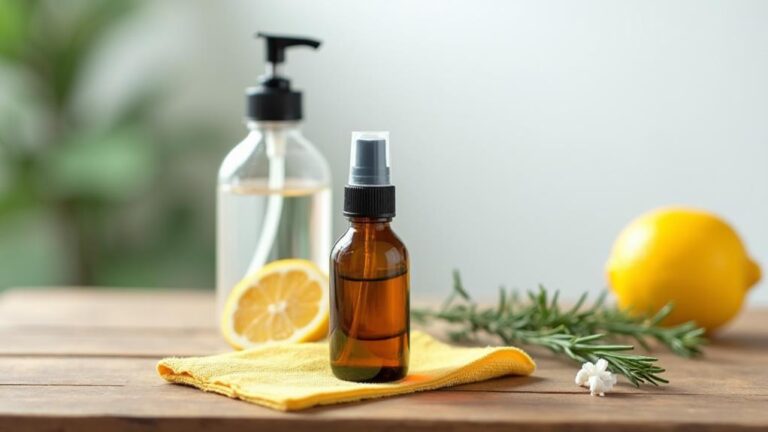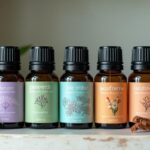As you consider creating your own essential oil cologne, you're probably wondering where to start. You'll need to choose the perfect blend of essential oils to reflect your unique style and preferences. But with so many options available, it can be overwhelming to narrow it down. What if you could craft a signature scent that captures your personality and complements your skin type? By following seven straightforward steps, you'll be well on your way to creating a one-of-a-kind cologne that's all your own. Let's take a closer look at how you can bring your vision to life.
Key Takeaways
- Choose essential oils that align with the desired scent profile and complement each other in fragrance families and scent profiles.
- Select a carrier oil that complements the skin type and desired benefits, such as moisturizing or reducing inflammation.
- Blend essential oils in trial and error process, adjusting proportions to achieve balance and harmony in the fragrance.
- Dilute the essential oil blend with a carrier oil at a 1-3% essential oil to 97-99% carrier oil ratio for a safe and effective cologne.
- Filter the mixture before bottling and let it age for at least 2 weeks to harmonize and settle the fragrance.
Choose Your Essential Oils
Choosing your essential oils is a crucial step in creating a unique and alluring cologne.
You'll want to ponder the scent profiling you're aiming for, whether it's floral, citrusy, or woody. Think about the emotions and moods you want to evoke with your cologne and the essential properties you need to achieve that.
Research the essential oils that align with your scent profile.
For example, if you want a calming and relaxing scent, you may ponder lavender or chamomile essential oils.
On the other hand, if you want an invigorating and uplifting scent, you may opt for peppermint or eucalyptus essential oils.
Ponder the top, middle, and base notes of your cologne.
Top notes are the initial scent you smell, middle notes are the rich, floral scents that emerge after the top notes fade, and base notes are the deep, rich scents that linger longest.
Choose essential oils that complement each other regarding scent profiling and essential properties.
Select a Base Ingredient
When creating your essential oil cologne, you'll want to choose a carrier oil that complements your selected essential oils and enhances their benefits.
A carrier oil will make up the bulk of your cologne, so select one that's gentle on skin and has the right consistency for your desired application.
You'll also need to ponder a base note, a rich and long-lasting fragrance that will ground your cologne and provide depth.
Choosing a Carrier Oil
Your essential oil cologne's foundation lies in its carrier oil, the base ingredient that makes up the bulk of the blend and plays a crucial role in diluting the potent essential oils.
You'll want to choose a carrier oil that complements your skin type and the benefits you're looking for in your cologne. For example, jojoba oil is rich in antioxidants and has anti-inflammatory properties, making it an excellent choice for sensitive skin.
Sweet almond oil, on the other hand, is rich in vitamins A, B, and E, and is easily absorbed into the skin, making it suitable for all skin types.
When selecting a carrier oil, consider the oil benefits you're looking for. Do you want to reduce inflammation, or hydrate your skin?
Different carrier oils offer unique benefits, so choose one that aligns with your goals. Some popular carrier oils for colognes include grapeseed oil, argan oil, and coconut oil.
Each of these oils has its own set of benefits, from moisturizing and nourishing the skin to providing a smooth, even texture.
Selecting a Base Note
A base note, often referred to as the base ingredient, serves as the foundation of your essential oil cologne's fragrance profile, providing depth and warmth to the overall scent.
When selecting a base note, consider the characteristics you want to achieve in your cologne. Base notes are typically rich, deep, and long-lasting, and they can evoke feelings of relaxation, grounding, and comfort.
Common base note ingredients include sandalwood, vanilla, and patchouli. Sandalwood is known for its woody, earthy scent, while vanilla adds a sweet, creamy note.
Patchouli, on the other hand, has a rich, herbaceous aroma. When choosing a base note, think about the scent profiling you want to achieve. Do you want a warm, spicy scent or a cool, fresh one?
Consider the top and middle notes you've already selected and choose a base note that complements them. You can also blend different base notes to create a unique fragrance profile.
Blend Your Fragrance
Typically, blending essential oils to create a unique fragrance involves some trial and error, but with a little patience and practice, you can craft a scent that's truly yours. To start, you'll want to ponder the fragrance families and scent profiles you've chosen for your cologne. Fragrance families are broad categories of scents, such as floral, citrus, or woody. Scent profiles, on the other hand, are more specific combinations of notes that evoke a particular mood or atmosphere.
| Fragrance Family | Scent Profile |
|---|---|
| Citrus | Uplifting and invigorating, evoking feelings of joy and energy |
| Floral | Romantic and feminine, perfect for evening wear or special occasions |
| Woody | Earthy and grounding, ideal for everyday use or outdoor activities |
| Oriental | Rich and exotic, great for making a statement or adding a touch of sophistication |
When blending your fragrance, start by combining small amounts of your chosen essential oils and testing the scent. You can adjust the proportions of each oil to achieve the desired balance and harmony. Remember, blending is an art, and it may take some experimentation to find the perfect blend.
Add a Fixative Agent
To extend the life of your essential oil cologne and prevent the fragrance from fading too quickly, you'll need to add a fixative agent.
This vital step involves choosing a fixative that complements your fragrance blend and understanding how to use it effectively without overpowering your scent.
Choosing the Agent
With your essential oil blend in hand, you're ready to take the next crucial step: adding a fixative agent to create a long-lasting cologne.
Fixatives have been used in perfume history to stabilize the scent of fragrances, preventing them from fading too quickly.
They work by binding to the essential oils, slowing down their evaporation rate.
When choosing a fixative agent, consider the type of fragrance you're creating.
Different fixatives are suited to different scents, so it's crucial to understand the characteristics of each one.
For example, orris root is often used in floral fragrances, while tonka bean is more commonly used in sweet, spicy scents.
In fragrance chemistry, fixatives are typically categorized into two types: natural and synthetic.
Natural fixatives, such as orris root and tonka bean, are derived from plants and are often preferred for their unique, subtle scents.
Synthetic fixatives, on the other hand, are created in a lab and can be more cost-effective.
Consider your personal preferences and the type of fragrance you're creating when selecting a fixative agent, as this is vital to achieving the desired result.
Using the Fixative
You've now selected the perfect fixative agent for your fragrance. Now it's time to use it to bring your cologne to life.
Fixative properties play a vital role in extending the life of your scent and preventing the top notes from fading too quickly. When adding a fixative agent, it's imperative to use a small amount, typically between 5-10% of the total formula.
There are several Fixative types to choose from, including orris root, tonka bean, and vanilla absolute. Each type has its unique Fixative properties that can enhance specific notes in your fragrance.
For example, orris root is commonly used to fix floral notes, while tonka bean is often used to fix sweet and powdery notes. When using a fixative agent, make sure to dilute it in a carrier oil, such as jojoba or sweet almond oil, before adding it to your fragrance blend.
This will help to prevent the fixative from overpowering the other essential oils in your blend. By using a fixative agent effectively, you can create a lasting and complex scent that will leave a lasting impression.
Dilute With Carrier Oil
Diluting your essential oil blend with a carrier oil is a crucial step in creating a cologne that's both effective and safe for your skin. Carrier oils help to dilute the essential oils, reducing the risk of skin irritation and making the fragrance last longer. When choosing a carrier oil, consider its moisturizing properties, shelf life, and compatibility with your essential oil blend.
| Carrier Oil | Benefits |
|---|---|
| Jojoba Oil | Moisturizing, stable, and non-greasy |
| Sweet Almond Oil | Soothing, nourishing, and easily absorbed |
| Grapeseed Oil | Lightweight, non-greasy, and rich in antioxidants |
| Avocado Oil | Nourishing, moisturizing, and rich in fatty acids |
| Coconut Oil | Hydrating, antimicrobial, and stable |
When diluting your essential oil blend, aim for an oil ratio of 1-3% essential oils to 97-99% carrier oil. This will help to create a fragrance that's subtle yet noticeable. You can adjust the oil ratio to suit your desired fragrance strength, but be cautious not to exceed 5% essential oils, as this can cause skin irritation.
Age and Filter Mixture
Now that your essential oil blend is diluted with a carrier oil, it's time to let the mixture mature and develop its unique character.
This process, also known as the aging process, allows the different notes of your cologne to harmonize and settle. You'll notice the scent becoming more complex and refined over time. Generally, it's recommended to let the mixture age for at least 2 weeks to a month, but you can age it for longer if you prefer a more mature scent.
Once you've allowed your mixture to age, it's time to filter it.
Filtering options include coffee filters, paper towels, or even a cheesecloth. The goal is to remove any sediment or impurities that may have formed during the aging process. You can also use a pipette or a glass syringe to carefully pour the mixture into a new container, leaving any sediment behind.
Filtering your mixture will guarantee that your cologne is clear and free of any unwanted particles, resulting in a smoother, more refined scent.
Bottle Your Cologne
Your filtered cologne is ready to be packaged in a way that showcases its unique character.
When selecting a bottle, consider a design that reflects the essence of your fragrance. Choose a bottle made of high-quality glass that will protect your cologne from UV light and preserve its potency.
Consider a dark-tinted glass bottle, as it will help maintain the stability of the essential oils.
For a cohesive look, pair your bottle with a stylish cap or stopper.
Some popular options include dropper caps, atomizer caps, or traditional screw-on caps. Think about the overall aesthetic you want to achieve and choose a cap that complements your bottle design.
Now it's time to add the finishing touch – a label.
Brainstorm some creative label ideas that capture the essence of your cologne.
You could include the name of your fragrance, a brief description of the scent, and the list of ingredients used.
Consider adding a personal touch, such as a quote or a message that resonates with your brand.
Keep your label design simple, yet elegant, to guarantee it complements your bottle design and showcases your unique cologne.
Frequently Asked Questions
Can I Use Expired Essential Oils for My Cologne?
You shouldn't use expired essential oils, as their oil shelf life has passed, leading to fragrance degradation and potential skin irritation or allergic reactions; it's best to discard them and use fresh, high-quality oils instead.
Is It Safe to Apply Homemade Cologne on Children?
"Better safe than sorry" applies when using homemade cologne on kids. You should use kid-friendly scents and consider age restrictions. Typically, children under 6 shouldn't use essential oils, while older kids can use diluted versions.
Can I Add Color to My Homemade Cologne Mixture?
When adding color to your homemade mixture, you'll need to choose colorant options that comply with cosmetic regulations, ensuring they're safe for skin contact and won't cause irritation or allergic reactions in users.
How Long Does Homemade Cologne Typically Last on Skin?
A thousand spritzes later, you're wondering about the staying power of your homemade cologne. Typically, you can expect a scent longevity of 4-6 hours on skin, with shelf life expectations of 1-2 years when stored properly.
Are Homemade Colognes Suitable for Sensitive Skin Types?
When exploring fragrances, you'll find that homemade colognes can be suitable for sensitive skin types if you choose skin-soothing essential oils and gentle fragrance options, taking into account individual allergies and skin reactions.
Conclusion
Your journey to crafting a bespoke cologne has been a winding path, much like a gardener nurturing a rare bloom. You've carefully selected each petal – the essential oils, the base ingredient, and the fixative agent. As you bottle your creation, the fragrance unfolds, a harmonious union of scents that reflect your essence. Your patience has been rewarded, and your unique cologne is now ready to flourish, a monument to the art of blending nature's beauty into a timeless elixir.




